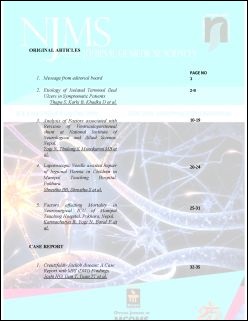Morphometric Study of Proximal end of Femur of Nepalese People
DOI:
https://doi.org/10.3126/njms.v4i1.24119Keywords:
femur, femur head, morphometry, neck shaft angleAbstract
Introduction: The femur is the largest and strongest bone of the body that forms the skeleton of the thigh. The morphometry of proximal end of femur are variable between different individuals with different Nationality. The aims and objective of the study is to find out the morphometric measurements- Femur Length, Femur head diameter, Femur neck shaft angle, and Femur neck length, breadth and thickness.
Methods: A total of 75 femurs of both sex were collected from the Department of Anatomy, MCOMS, Pokhara. The parameters on proximal femur were measured manually with the help of measuring scale, thread, protector and vernier calliper. The collected data were analyzed with Microsoft Excel 2007 software and represented graphically.
Results: In the present study, the average femoral length for entire femur was 42±2.81 cm, femoral head diameter was13.05±0.9 cm, femoral neck length was 4.12±0.32 cm, femoral neck breadth was 2.94±0.30 cm, and femoral neck thickness was 2.36±0.42 cm. The femur neck shaft angle of left femur was significantly higher than that of right femur (P-value 0.03). There was no difference between other dimensions of proximal end of right and left femur.
Conclusion: The results of the present study show that the dimensions of proximal femur in Nepalese Population are different as compared to other countries population. The knowledge of different dimensions of proximal femur will be important in anthropological and medico-legal practice for sex determination and as well as to radiologists and orthopaedic surgeons for diagnosis and planning of treatment.
Downloads
Downloads
Published
How to Cite
Issue
Section
License
Copyright © by Nepal Journal of Medical Sciences. The ideas and opinions expressed by authors of articles summarized, quoted, or published in full text in this Journal represents only opinions of authors and do not necessarily reflect the official policy of Nepal Journal of Medical Sciences or the institute with which the author(s) is (are) affiliated, unless so specified.




